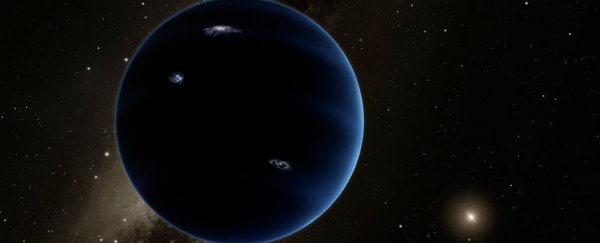We keep hearing about Planet Nine - the proposed new planet in the Solar System that might be herding asteroids out past Pluto - but astronomers are having a hard time actually finding it.
New planets and asteroids have only ever been found using reflected sunlight. Our Sun sends out light in all directions, and a tiny amount of it bounces off a planet or asteroid, then an even tinier amount bounces back towards Earth.
Planet Nine probably receives around half a million times less sunlight than we do here on Earth, which is going to make finding it this way extremely tricky. But according to two new studies, we might be able to find it using light emanating from within the planet itself.
Everything in the Universe emits what's called black-body radiation, where hotter objects shine in more energetic light and cooler objects shine in less energetic light. It's why metal starts to glow red or orange when it's heated up. And it isn't because objects suddenly get hot enough to start emitting light - they're always emitting light, but the kind of light they emit changes as they get hotter.
Once an object passes a certain temperature, the light it emits starts to overlap with the light we can see, and it looks like they're glowing red-hot. Once they cool down, the light they emit goes back to being invisible to our eyes, but it's still being emitted just the same.
This is also why infrared goggles can find people: people glow in the infrared, and our warmer parts (our faces and torsos) glow in slightly different light than the cooler parts do.
Black-body radiation gives us a way to see Planet Nine, which probably emits light that's right on the border between the infrared and microwaves. Conveniently, we have telescopes that search the sky for light on the border of the infrared and microwaves.
That's the idea behind papers by two different teams that say we should use Planet Nine's black-body radiation to first find it, and then learn more about it.
The first group, led by Nicolas B. Cowan from McGill University in Canada, started out by asking whether our telescopes could even see something as cold, slow, and distant as Planet Nine. In their paper, they give the current best estimates for how hot Planet Nine is and how much light it produces, which together with the distance to the planet tell them how bright it should be to us.
They found that, unless their estimates are way off, we could probably find Planet Nine using current telescopes. The telescopes just need to be pointed in the right places.
Even better, even if those estimates are a bit far off, Planet Nine will probably still be visible to telescopes that are currently being planned, they say. Either way, we're probably on the cusp of detecting this new planet for the first time.
The second group, led by Sivan Ginzburg from the Hebrew University of Jerusalem, Israel, went even further, claiming that the specifics of its black-body radiation could teach us about Planet Nine's size and its atmosphere.
All of the planets in our Solar System have been cooling since they were formed about 5 billion years ago. The planets that have big, thick atmospheres have generally cooled much more slowly, because the atmospheres tend to act like big, thick blankets that trap the planet's heat and slow down the cooling.
By modelling Planet Nine with the assumption that it's a lot like Uranus or Neptune, Ginzburg's team was able to find a relationship between the thickness of its atmosphere, its mass, and the black-body radiation. So once we measure that radiation, we pretty much get the other two for free.
Since we're probably on the verge of detecting this radiation, it won't be long before we know something about Planet Nine's composition, too.
The big physics news of 2016 was the discovery of gravitational waves. The big news of 2017 might be finding and understanding Planet Nine…
The new papers have been published in The Astrophysical Journal Letters, and you can access them here and here.
